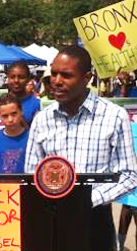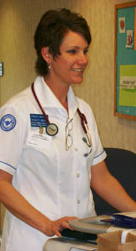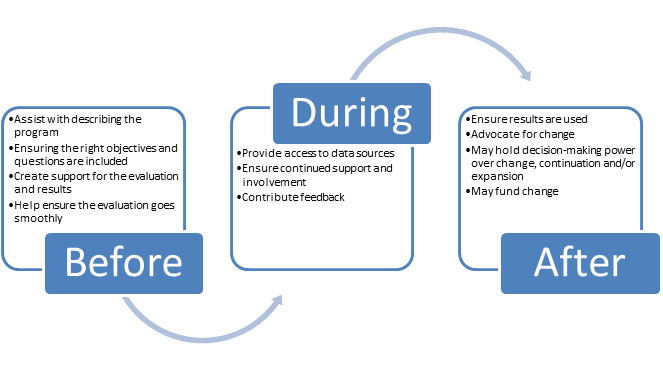Engage Stakeholders
A critical first step of the CDC's evaluation framework is engaging your stakeholders. In this section, we will touch on how to identify your stakeholders, ways to engage them, and how best to balance these important relationships with the goals of the evaluation.
Note that this step can be done in conjunction with the next step, Describing the Program, as some of the activities may overlap or be useful to do in tandem.

Stakeholders are those who are invested in the program or the outcomes associated with the program. As such, they are interested in the evaluation or what will be done with the results. Stakeholder can be individuals, groups and/or entire organizations.
To illustrate, let's return to our case study...
Below are some of the potential stakeholders in the Health Bucks evaluation. Take some time to explore each of these. Pay particular attention not only to the role of each, but also the piece or pieces of the evaluation which may be most important from their perspective.

SNAP participants and other high-risk individuals targeted by the program
As the main target population for the program, SNAP participants are ideally situated to provide a critical perspective regarding Health Bucks. Their real world experience will help identify strengths and weakness of the program, and whether services are reaching them as intended. It will also be important to consider and include those who do not currently use the program to understand their perspectives and barriers to participation.
Spin: As the main target group they stand to gain (or lose) a great deal depending on the program’s future. Those who have used and enjoy the program have a vested interest in seeing it continue and strengthened.

Farmers' Market Federation of New York
Their markets are a critical piece/input of the Health Bucks service, providing the infrastructure for delivering the extra dollars for SNAP participants to spend and the healthy food for purchase.
They may have access to data useful to the evaluation and have the power to help make changes to the program post-evaluation.
Spin: The Federation may come into the evaluation with a pre-conceived notion on how the program impacts their business with a view towards the end goals of encouraging more vendors and consumers to engage within the Farmers market setting.

Staff from each of the three NYC District of Public Health Offices
Staff from participating boroughs will offer unique perspectives regarding the day-to-day infrastructure of the program.
They may be best situated to help you identify the program goals, inputs, outputs and details of program implementation. Additionally, they may have access to data helpful for the research.
Spin: Their intimate involvement with the program's design and implementation is a major strength, but this may skew their opinions regarding the program's future.

Farmers market operators, vendors and managers
As the day-to-day deliverers of the program's key output, they will have important information regarding the execution of the program on the day of the markets.
They may help to highlight drivers and potential barriers for their customers and can provide data regarding overall purchases at their stalls, and the proportion purchased with Health Bucks.
Spin: Similar to the Federation, these stakeholders may be driven by the impact of the program on their business.

Program coordinators from local community-based organizations
Coordinators may have data to share on the populations they serve, usage rates of the program, and user feedback.
Similar to public health department staff, they can provide insight on the day-to-day implementation details and challenges of the program.
Spin: Depending on their views of the program, they may have a vested interest in seeing it change or expand as they are intimately involved in the program details and may have high loyalty to the target population.
Considering the the different stakeholders and their respective roles, review the list of roles below and try to match it to the stakeholders also listed below.
- DPH Staff
- Farmers Market Operator
- Farmers Market Federation
- Program Coordinators from local community-based organizations
- Advocate for change and/or to expand this effort to other cities.
- Fund/authorize continuation, changes or expansion.
- Give credibility to the evaluation.
- Involved in program implementation.
Major Stakeholder Groups
The CDC's Introduction to Program Evaluation for Public Health Programs identifies three major groups of stakeholders. These can be helpful for thinking through the key stakeholders in your evaluation. However, keep in mind that these categories are meant as a guide, and groups are not mutually exclusive.
Stakeholders may be those who are...
- Involved in program operations - program managers, staff, funding agencies, partnerships
- Served or affected by the program - patients, communities or community members, clients
- Users of the evaluation findings - could vary greatly from funding agencies, to program boards, to the general population
Regardless of their exact role, stakeholders play an important role throughout an intervention and evaluation.

Scenario: Safe Ride Program Evaluation
Next, imagine you are an evaluator for the Safe Ride Program, which is a program offering designated drivers to students on a college campus with the goal of reducing instances of drunk driving by students.
A stakeholder list has been built by the program evaluation team, which includes the following:
- Dean of Student Life,
- Campus Health and Safety Director,
- Student Body President,
- Safe Ride Program Administrators,
- Safe Ride Drivers,
- Student Body Representatives (users and non-users).
Use this information to complete the following series of activities.
For the Safe Ride scenario, you have identified the stakeholders shown below. Match them to their respective roles. Note they can have more than one.
- Dean of Student life
- Campus Health and Safety Director
- Student Body President
- Safe Ride Program Administrators
- Safe Ride Drivers
- Student Body Representatives
- Advocacy
- Implementation
- Improve credibility
- Funding/Authorizing decisions
And now, considering the same scenario, answer the questions below to determine at what times you think various players should be consulted during the evaluation process of the Safe Rider Program.
Below is a checklist of considerations for the Engage Stakeholders step from the CDC manual for Health Program Evaluation. Feel free to review and print for your records.
Engaging Stakeholders Checklist
- Identify stakeholders based on broad categories such as: those affected, those involved in operations, and those who will use the evaluation results
- Review this initial list of stakeholders to identify the key stakeholders you will need to improve credibility, implementation, advocacy, or funding/authorization decisions
- Engage individual stakeholders and/or representatives of stakeholders organizations
- Create a plan for stakeholder involvement and identify areas for stakeholder input

